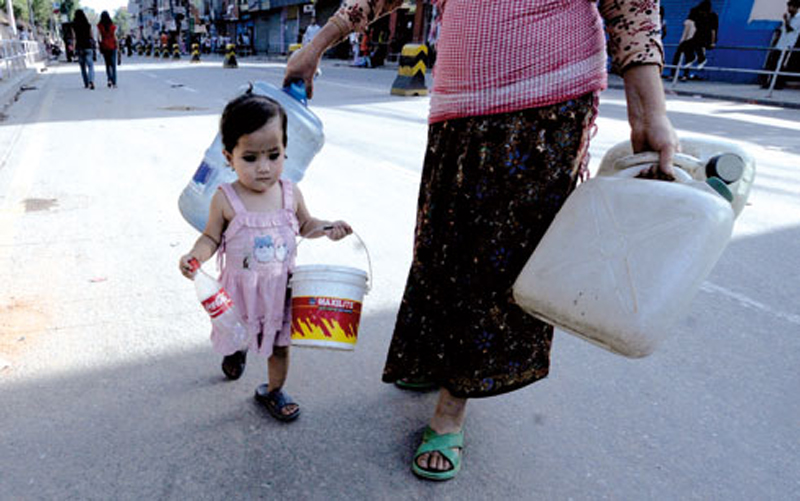
OR

Kathmandu residents can’t pin their hopes on Melamchi, which, when complete, will meet only one-third of the valley’s demand.
According to the Groundwater Resource Development Board (GRDB) groundwater levels in different areas of Kathmandu valley have significantly declined over the past five years. While massive exploitation of natural resources and unmanaged industrialization have led to this drastic decrease in water levels, what’s more alarming is government’s nonchalant attitude towards it. Unless there is a quick policy reform, a severe water crisis could ensue, affecting millions of lives in the valley and beyond.
Groundwater comprises half of the total watershed area and continues to be an essential source of water supply in Kathmandu valley. One study carried out by the International Center for Integrated Mountain Development (ICIMOD) claims that in Kathmandu groundwater delivers nearly half of the total water supply during wet season and almost three-quarters in the dry season. Anecdotal evidence further suggests that haphazard development of groundwater in the recent past emanates from inefficient spatial resource distribution in different time periods. Under these circumstances, tragedy of the commons is inevitable, with staggering levels of annual groundwater extraction that far exceeds recharge.
The inhabitants of Kathmandu valley, unfortunately, can’t hope for a respite from despite all the hoopla surrounding the Melamchi Drinking Water Project (MDWP). In spite of Rs 16 billion in investment so far, MDWP, when completed, is expected to serve only one-thirds of total demand. Consumers, both residential and commercial, have consequently shifted to groundwater extraction. With its five-star hotels extracting more than 10 million liters of groundwater every day, the total amount of groundwater extracted in Kathmandu valley comes to around 120 million liters a day.
Rampant extraction of groundwater has led to several adverse results, including degradation in water quality and reduction in aquifer volume due to land subsidence. Although no current research documents the prevalence of subsidence, over-exploitation of groundwater are leading to quite visible pandemics. For instance, groundwater in shallow aquifers is more likely to be contaminated by E. coli and nitrates, while deep aquifers are infected with ammonia, arsenic, iron and heavy metals.
Sadly, the government seems happy to be a mute spectator. Its response to the problem faced by some villagers in Siraha district three years ago is a case in point. People living to the north of the East-West Highway in Siraha faced an acute shortage of water, with local water levels receding and tube wells drying. Yet the government failed to take any action to serve affected communities. This, in turn, led the villagers to leave their ancestral homes and there ensued massive migration to the south. Recent government decision to allow mining of stone, gravel, sand and boulders from riverbeds, conservation areas and national parks without carrying out environmental impact assessment (EIA) paints the same depressing picture.
Although the seventh National Groundwater Symposium last year was a welcome step, more needs to be done at the policy level. As it is, the governmental-controlled Kathmandu Upatyaka Khanepani Limited (KUKL) has been unable to meet the steep demand of 360 million liters of water a day in Kathmandu valley; KUKL manages to supply barely half of the estimated demand and even then obtains 50 percent of its water through shallow and deep tube wells. It is perhaps unaware of the findings of recent research on hydrogeology and groundwater quality in Kathmandu.
In recent years the perennial water shortage in the valley has encouraged environmentalists and social entrepreneurs to propose alternative solutions. The valley receives more than three-quarters of approximately 1,700 mm of rainfall in the country during the monsoon. This translates to harvesting of at least 1,400 liters of water per square meter on every rooftop. The water thus harvested could then recharge the aquifers.
In the end, there is an urgent need to come up with effective policies aimed at managing groundwater sustainably. Moreover, the existing gap between think tanks and policy makers needs to be bridged through constant interaction among economists, scientists and relevant stakeholders, both in and out of government. In addition, consumers are unlikely to stop pumping water even if they are cognizant of potential environmental risks. They could, however, substitute to alternative sources of water, such as river harvesting, if they are offered the right incentive.
There is no alternative to sound policies to mitigate the unintended consequences of unsustainable use of water in Kathmandu. Any more delay could prove extreme costly.
The author is a PhD candidate in environment and resource economics
jpaudel@umass.edu
You May Like This

SC orders govt to control dust pollution in Valley
KATHMANDU, Feb 1: The Supreme Court, issuing an interim order on Wednesday, has instructed the government and authorities concerned to take... Read More...

Valley Public, HHCA win inter-school basketball titles
KATHMANDU, Nov 19: Hosts Valley Public and Himalaya Health Care Academy (HHCA) claimed the girls’ and the boys’ titles respectively... Read More...

21 confirmed cases of cholera in Kathmandu Valley
KATHMANDU, July 27: Epidemiology and Disease Control Division (EDCD) under Department of Health Services (DoHS) has sounded alarm about cholera... Read More...




Just In
- Govt receives 1,658 proposals for startup loans; Minimum of 50 points required for eligibility
- Unified Socialist leader Sodari appointed Sudurpaschim CM
- One Nepali dies in UAE flood
- Madhesh Province CM Yadav expands cabinet
- 12-hour OPD service at Damauli Hospital from Thursday
- Lawmaker Dr Sharma provides Rs 2 million to children's hospital
- BFIs' lending to private sector increases by only 4.3 percent to Rs 5.087 trillion in first eight months of current FY
- NEPSE nosedives 19.56 points; daily turnover falls to Rs 2.09 billion
















Leave A Comment